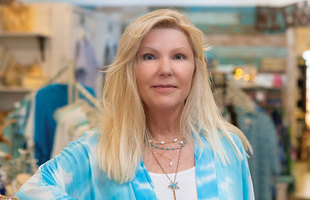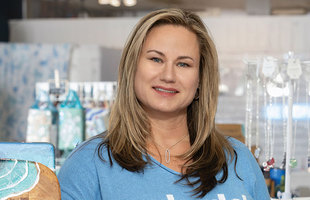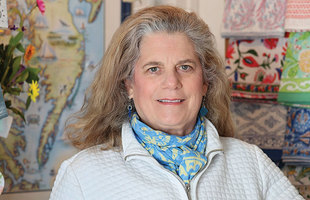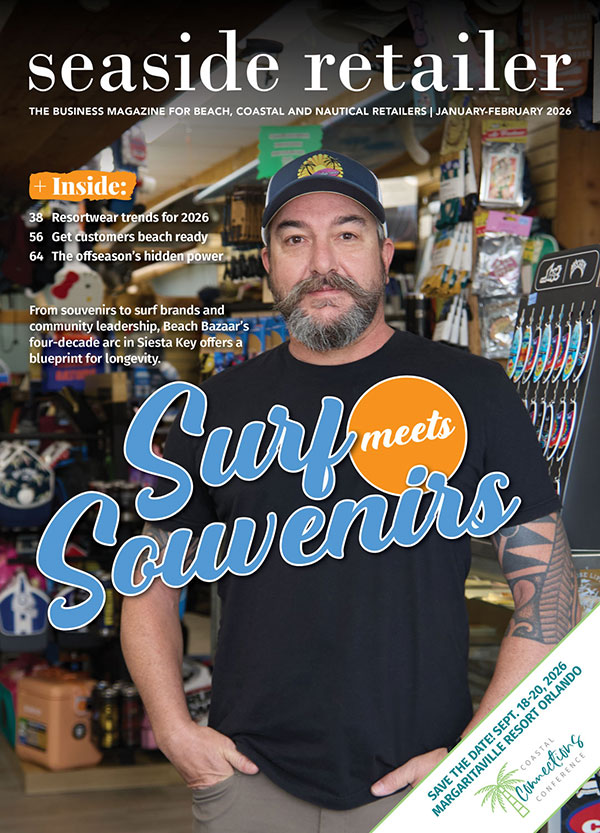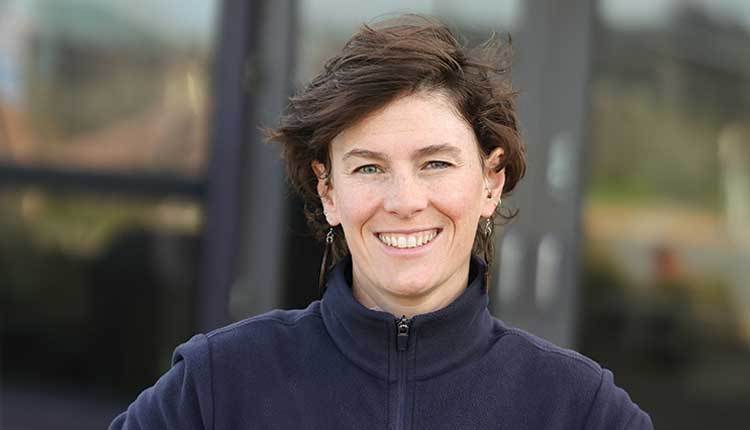
The gift shop at the Seymour Marine Science Discovery Center on the University of California’s Santa Cruz campus is no larger than the average family’s living room. In fact, the seaside learning center didn’t even have a building until 2000.
“Prior to that, we actually had volunteers who would gather groups of people and take them on tours of our research facilities,” explains Emily Casaretto, visitor experience and gift shop manager. “It was kind of threadbare. They were operating out of tubs of educational materials and a portable classroom for 15 to 20 years.”
Then in 2000, funds were raised to build a 20,000-square-foot visitor center, according to the university’s website. Suddenly, an indoor facility filled with “touch tanks” housing hermit crabs, starfish, sting rays and swell sharks brought the wonder of the ocean even closer to curious visitors.
“The focus on ocean science is probably one of the main differences,” Casaretto notes of the facility compared to a public aquarium. “As part of the university, our job is to showcase the amazing research that our faculty and our students do here.”
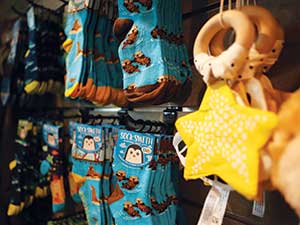
While researchers and students thoughtfully work to understand life underwater, they invite guests to pull up a chair and take in the beauty of the Monterrey Bay — home “year-round to harbor seals, southern sea otters, bottlenose dolphins, and two porpoise species” according to the center’s website.
Casaretto believes guests take comfort in the smaller, more intimate setting provided by the only working research laboratory in California open daily to the public. Along with a passion for the ocean comes a desire to take a piece home.
“The guiding principle of having a gift shop in our center is how do we help people take a piece of their love for the ocean home with them,” Casaretto explains. “And how do we provide items that they can purchase that build on this education and this enthusiasm for the ocean?”
The small shop brims with coastal- themed drinkware, postcards, magnets, apparel, toys, books, plush, jewelry and home decor meant to remind guests of their glimpse of the ocean floor and the treasures just beneath the surface.
“I think the most common thing I hear is ‘there are so many fun things in here,’” Casaretto says with a smile. “That makes me feel good because that’s the point is to have it feel like this sort of wonderland.”
Since taking over the operation in 2019 when the original shop manager retired, Casaretto says she’s retained some inventory while putting her own stamp on what she feels is important.
“I think the most common thing I hear is ‘there are so many fun things in here.’ That makes me feel good because that’s the point is to have it feel like this sort of wonderland.” — Emily Casaretto
“I had heard from some people in the past that sometimes it felt like it was cluttered,” she admits. “So, I’m trying to make it feel full, but not feel like the walls are closing in. I want to have a large variety of interesting things for people to buy, but it’s also important to have accessibility so someone in a wheelchair or someone pushing a stroller is able to move around. Trying to find that balance is a pretty important.”
A delicate balance
For Casaretto, balance comes in many forms. With a master’s degree in coastal policy and a background in retail, taking on her current role nearly two years ago became a way of satisfying both interests.
“I’ve been in retail and hospitality since I was 15, but I also have a passion for building people’s relationships to the ocean,” she notes. “So, it’s the best of both worlds with the interests and skill sets that I have.”
With seven part-time undergraduate students running the cash register, Casaretto is responsible for all other aspects of the shop, including ordering, receiving, inventorying and budgeting for merchandise.
As a one-woman-show, she says some of her top priorities revolve around pricing, which can be challenging at times.
“The biggest dedication I have is to keeping things affordable for people. The cost of everything from the supply side has gone up,” she notes. “And I want to keep a variety of things at different price points in the shop because I really do believe that there should be something for everybody here.”
As a small nonprofit, however, Casaretto acknowledges sometimes the budget gets the final say.
“Since we are a nonprofit, there are limits to how we stay afloat as an organization and how we make sure we’re mindful of our expenses,” she points out. “So that’s challenging at times.”
To maintain the pendulum between affordability and variety, Casaretto looks to local artists to harvest their creative talent.
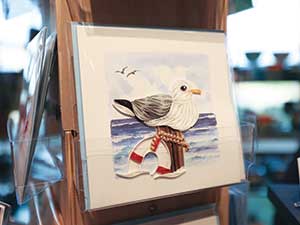
“We’re very lucky to live in a community of people that have a lot of artistic talent who choose to use the ocean or animals that live in the ocean as their inspiration,” she explains. “So, it’s not a challenge for me to find people that are making really incredible artwork with an ocean theme. And I like to support them as much as I can.”
For this reason, a nearby husband-and-wife team called Big Sur Handworks is Casaretto’s go-to for most apparel, with one manning the design while the other is in charge of screen printing for the operation.
Meanwhile, another local — a professor’s daughter — makes earrings out of abalone shells. Casaretto stresses that she normally wouldn’t carry items in the gift shop made from things collected off the beach; however, in this case, the material is harvested from an abalone farm that are remnants of other pieces that would be otherwise thrown away.
“She makes these really beautiful, delicate earrings out of these tiny little abalone shells,” Casaretto says.
“That’s been a big part of why I think our gift shop has been successful is that people seek out unique things that they can’t find in other shops.”
Outside of ordering plush from Wild Republic and books from Ingram Publishing, Casaretto also works to carry items that promote an educational experience outside of the building, such as field identification guides and educational activity books for children.
One of her most surprising bestsellers, she notes, is her custom, name-drop merchandise. Whether apparel, magnets, ornaments, stickers or patches, Casaretto says the vessel doesn’t matter as much as the message.
“When you take the time to put your name on a product, people really love it, because it’s something that they can’t find at other places. Pretty much everything that I’ve decided to do a custom version of is a success,” she points out. “Because we’re such a small organization, I’m like who’s going to want something with our name on it, but people really do love it.” And more importantly, they’re compelled to buy it.
Made for the position
As for what Casaretto loves, she has a difficult time choosing just one part of her job to highlight. After thoughtful consideration, she comes full circle to her two passions — retail and the ocean.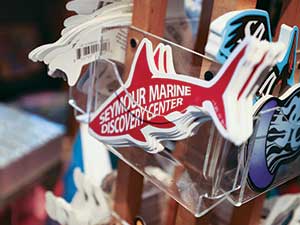
“For me, there’s, a level of excitement that comes with being part of the retail side of our organization,” she says. “And I love creating an opportunity for our visitors to take something home with them.”
More importantly, she notes, is seeing the ripple effect of the work at the research facility in the community where she lives.
“I ride my bike to work, and it makes me happy when I ride the bike path and see a family with a child carrying a stuffed animal that I know they bought from us,” she notes. “We’re part of the campus, so there’s not another gift shop next door, so if there’s a kid carrying a shark stuffed animal around, I know where they got it.”
As a child who was enthralled by the ocean, Casaretto says nothing makes her happier than making a connection for another who may someday stare out at the Monterrey Bay as a student or faculty member.
“If you had told me as a child that when I would have an office full of snacks and stuffed animals, I would be like, ‘Oh, that sounds like my dream,’” she quips.
Casaretto admits the fact that the child within her is allowed to come out as part of her grown-up job is just one of the many perks.
“There’s an amount of satisfaction I get from just knowing there’s a lot of play in my everyday life because of my job, and that makes me really happy.”
